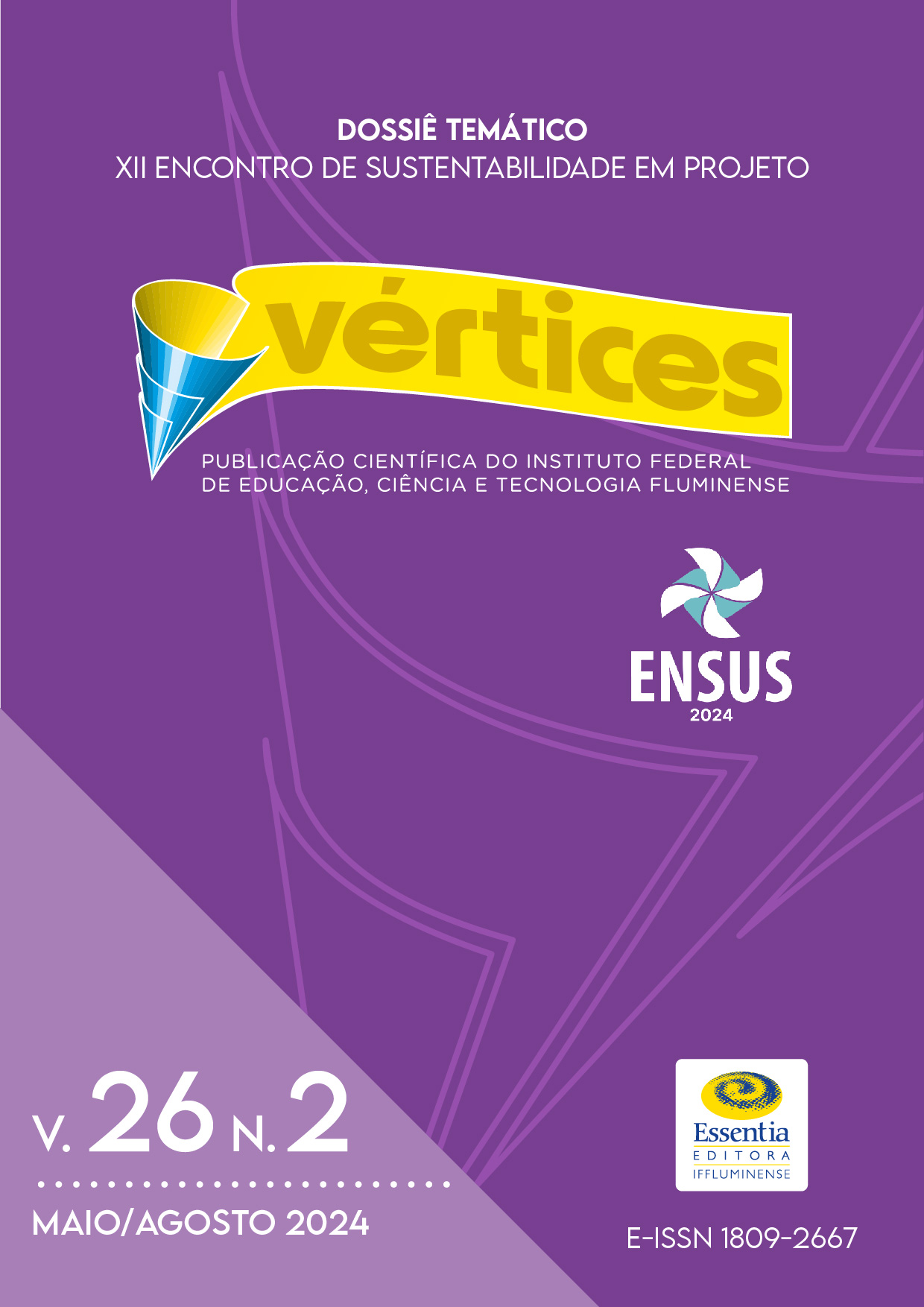Design methodologies and sustainable design: a partnership report with the Pernambuco Environmental Institute
DOI:
https://doi.org/10.19180/1809-2667.v26n22024.23402Keywords:
design processes, sustainability, textile wasteAbstract
This article reports the experience of the Low Complexity Product Design discipline, taught in the design course at UFPE – Agreste campus, in collaboration with the Pernambuco Environmental Institute (IMOA). IMOA aims to support families in situations of social vulnerability, promoting community development and sustainable awareness. The main challenge was to create products from textile waste donated by the Caruaru fashion industry, aiming to generate income and promote social, economic, and environmental sustainability. As a result, proposals were developed that cover several product categories, encouraging reflection on the interaction between academia and society through extension activities carried out in the classroom.Downloads
References
ABREMA. Panorama dos resíduos sólidos no Brasil. 2023. Disponível em: https://www.abrema.org.br/wp-content/uploads/dlm_uploads/2024/03/Panorama_2023_P1.pdf. Acesso em: 2024.
BATISTA, A. S.; GUILHON, D.; FIGUEIREDO, K. B. Embalagem Sustentável: usabilidade de papéis biodegradáveis na produção de embrulho para produtos vinculados à cadeia de artesanato em São Luís-MA. Anais do Colóquio Internacional de Design, v. 8, n. 5, p. 856-870, 2020. DOI: http://doi.org/10.5151/cid2020-66. Disponível em: https://www.proceedings.blucher.com.br/article-details/35891. Acesso em: 2024.
BAXTER, M. Projeto do produto: guia prático para o design de novos produtos. Tradução Itiro Iida. 3. ed. São Paulo: Blucher, 2011.
BRASIL. Lei nº 12.305, de 2 de agosto de 2010. Institui a política nacional de resíduos sólidos. Brasília, DF: Presidência da República, [2010]. Disponível em: https://www.planalto.gov.br/ccivil_03/_ato2007-2010/2010/lei/l12305.htm. Acesso em: 2024.
BROWN, T. Design thinking. Harvard business review, v. 86, n. 6, p. 84, 2008.
BUZON, D. Design Thinking is a Rebrand for White Supremacy. Medium, Retrieved November, v. 30, p. 2022, 2020.
CARDOSO, R. Design para um mundo complexo. São Paulo: Cosac Naify, 2012.
CNN. Brasil descarta mais de 4 milhões de toneladas de resíduos têxteis por ano. 2022. Disponível em: https://www.cnnbrasil.com.br/economia/brasil-descarta-mais-de-4-milhoes-de-toneladas-de-residuos-texteis-por-ano/. Acesso em: 2024.
GRIZIO-ORITA, E. V.; SILVA, M. E. C.; MASSI, F. O.; SARTOR, M. J. Análise do design de algumas embalagens utilizadas na Universidade Estadual de Londrina. 2021. Disponível em: https://operobal.uel.br/wp-content/uploads/2021/08/design-de-embalagens.pdf. Acesso em: 2024.
GUILHON, D.; CASTRO, E. V.; SILVA, V. P. Perfil cromático de embalagens de produtos lácteos – um estudo preliminar. In: CONGRESSO INTERNACIONAL DE DESIGN DA INFORMAÇÃO - CIDI, 10., CONGRESSO NACIONAL DE INICIAÇÃO CIENTÍFICA EM DESIGN DA INFORMAÇÃO, 10., 2021. Anais […]. p. 131-148.
IMOA (@imoa.pe). É até difícil imaginar que esses ursinhos um dia já foram restos de tecidos. Instagram, 18 jun. 2021. Disponível em: https://www.instagram.com/p/CQRV6-dH3na/. Acesso em: 2024.
IMOA (@imoa.pe). Educar e sustentar, essa é a nossa missão. Instagram, 25 jan. 2024. Disponível em: https://www.instagram.com/p/C2ijUsuvTSP/?igsh=MXJsZW4xNGRiaTVrbQ==. Acesso em: 2024.
IMOA (@imoa.pe). Relatório Anual 2023. Instagram, 11 jan. 2024. Disponível em: https://www.instagram.com/p/C19-pgFr_yi/?img_index=1. Acesso em: 2024.
LÖBACH, B. Design industrial: bases para configuração dos produtos industriais. São Paulo: Blucher, 2001.
MORAES, D. Metaprojeto como modelo projetual. In: MORAES, D.; DIAS, R. A.; CONSELHO, R. B. (org.). Método: Cadernos de estudos avançados em design. Barbacena, MG: Eduemg, 2011. v. 2, p. 35-52.
MUNARI, B. Das coisas nascem coisas. 2. ed. São Paulo: Martins Fontes, 1981. 388 p.
NAÇÕES UNIDAS BRASIL. Sobre o nosso trabalho para alcançar os Objetivos de Desenvolvimento Sustentável no Brasil. 2024. Disponível em: https://brasil.un.org/pt-br/sdgs. Acesso em: set. 2024.
PAZMINO, A. V. Como se cria: 40 métodos para design de produtos. São Paulo: Blucher, 2015.
PESSÔA, C. R. Parâmetros para a qualificação de ações sustentáveis. In: WANDERLEY, R. G. (org.). Nutrientes criativos: resíduos de confecções. Recife: FacForm, 2019. p. 28-38.
TEIXEIRA, S. A.; NAKATA, M. K. Design do Origami: um estudo sobre técnicas projetuais com dobras e desenvolvimento de bolsa-origami sustentável. Educação Gráfica, v. 24, n. 1, p. 429-448, 2020. Disponível em: https://www.educacaografica.inf.br/wp-content/uploads/2020/06/28_DESIGN-DO-ORIGAMI_429_448.pdf. Acesso em: 2024.
TORRES, M. L. Diretrizes de projeto com enfoque nos afetos e na memória positiva orientada à sustentabilidade. DAT Journal, v. 6, n. 1, p. 245-265, 2021. DOI: https://doi.org/10.29147/dat.v6i1.339. Disponível em: https://datjournal.anhembi.br/dat/article/view/339. Acesso em: 2024.
Downloads
Published
Issue
Section
License
Copyright (c) 2024 Pedro Henrique de Siqueira Leite, Ana Carolina de Moraes Andrade Barbosa

This work is licensed under a Creative Commons Attribution 4.0 International License.
The authors of the manuscript submitted to Vértices, hereby represented by the corresponding author, agree to the following terms:
The authors retain the copyright and grant Vértices the right of first publication.
At the same time the work is licensed under the Creative Commons Attribution 4.0 International License, allowing third parties to copy and redistribute the material in any medium or format and to remix, transform, and build upon its content for any legal purpose, even commercially, provided the original work is properly cited.
Authors will not receive any material reward for the manuscript and Essentia Editora will make it available online in Open Access mode, through its own system or other databases.
Authors are authorized to enter into additional contracts separately for non-exclusive distribution of the version of the work published in Vértices (eg, publish in institutional repository or as book chapter), with acknowledgment of authorship and initial publication in this journal.
Authors are permitted and encouraged to disseminate and distribute the post-print (ie final draft post-refereeing) or publisher's version/PDF at online information sources (eg, in institutional repositories or on their personal page) at any time after the first publication of the article by Vértices.
Essentia Editora may make normative, orthographic and grammatical changes in the originals in order to maintain the standard language, with the final consent of the authors.
The content and opinions expressed in the manuscript are the sole responsibility of the author (s).























1.png)



